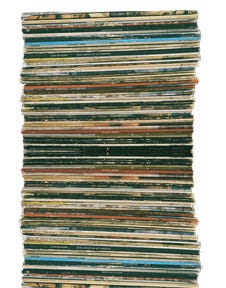The Record Store Years 17) The Advent of The Melt
A memoir of 25 years (1975-2000) spent working in the world of records & music in Seattle, with occasional side trips into writings on Led Zeppelin and other adventures from my musical life.
At some point in the late ‘70s, the record industry started recycling vinyl by melting down unsold or returned product and using the vinyl to press new records. I believe this was motivated more by cost-cutting greed than any good environmental intentions, and quality control didn’t seem to be a high priority - defective LPs seemed to start turning up more often in this period, often with chunks of paper from old LP labels molded into the grooves of a new album.
The labels were generally recycling their own new product from returns, however there was some talk in the trades of recycling vinyl records in a general sense, and when Cellophane Square’s owners heard about this they decided that we should be buying any and all vinyl that came in and start stockpiling this product for recycling by some as yet unknown entity at some indeterminate point in the future.
Up to this point we’d been turning away records that had no sales potential or were in terrible condition, but in 1977 or so we instituted the policy of paying a nickel for any LP that came in the door, regardless of artist, title or condition. Some customers were insulted when offered such a low price, but many more – in fact the vast majority – were willing to part with the unsellable stuff and at least get something for it, rather than cart it home again. And so Cellophane Square started accumulating vast quantities of ‘melts’, as we called them, and so began decades of storage nightmares, the juggling of huge heavy boxes of records that we couldn’t sell, and endless debates between management and the owners about what to do with them since it turned out that they were not recyclable after all. My recollection is that the outfits that recycled vinyl for the labels were not interested in dealing with outside sources like used record stores.
One of my enduring memories of the early years is moving a load of melts from the U-District store to the owner’s house 20 miles north of Seattle for storage in their garage, since we’d filled up the allotted space at the store several times over. This was before there were any company vehicles, and for some reason I can’t remember now I was tasked with moving as many LPs as I could fit at one time into my girlfriend’s 1967 red Volkswagen Beetle. I loaded the records unboxed into the car so more could be squeezed in, and by the time I was done the front boot, back floor & seat and the front floor & passenger seat were all packed tight with records. The poor car was almost scraping the ground and the little 4-cylinder engine could barely deliver 35 mph, but I made the trip successfully and it was only the first of many delivery runs of all types, in a variety of vehicles, that I performed over the years.
Above: Not one of my runs, but I can relate.
As the melt stock got bigger and bigger over the years it became something of a despised albatross in the company, but there were a few silver linings to the failed recycling program. One was that after 10 or 15 years of sitting on a stockroom shelf, some of the records that had no sales potential when they were first brought in had become desirable and in some cases, collectible. There were at least a few instances where I stumbled on something in the melts that was worth $10 or $20 in the current market and would pull it out and sell it. The other benefit was that in the vast pile of crap that was the melts there were thousands of kitschy, cornball album covers – lots of cheesecake too – stuff that was looked down on and dismissed in the ‘70s and five decades later has now become hip, retro-kitsch ephemera to which many books, blogs, websites, and even entire brick-and-mortar stores are devoted.
All the classics were in there – Music For Big Dame Hunters, the legendary ‘Faithtones’ album, Martin Denny’s Exotica series, those great “10,000 Guitars of Tony Motolla” type of things – and many of us, myself included, built collections of LPs based entirely on their cover art for mere pennies after our employee discount. The walls of my music room are still decorated with a rotating assortment of these covers today, including a few that have gained considerable value over the years.
Despite these silver linings, I don’t believe Cellophane Square ever came close to realizing any profit on the melts – in fact it’s unlikely that we even broke even on all those nickels spent. Regardless, there was value in the policy of buying everything purely in the sense of customer relations. Most people were relieved and happy that we’d make an offer on everything they brought in, and the policy became a cornerstone of Cellophane Square’s stellar reputation as a good place to sell your records.
NEXT: The Pitfalls of Hiring Fanatics Pt. 1: The Music Knowledge Test







my score from the melt pile was Albert King's " Born Under a Bad Sign" original Stax. Vinyl looked a bit worn, but plays great. Still own that gem. Kinda wished I would dove deeper into the melt pool and see what more I could of come up with. Then no real work would've gotten done.
The melts! I can't even imagine where you guys were storing these in the old store. There was barely enough room to do regular business in there, let alone store thousands of LPs! The mind reels.